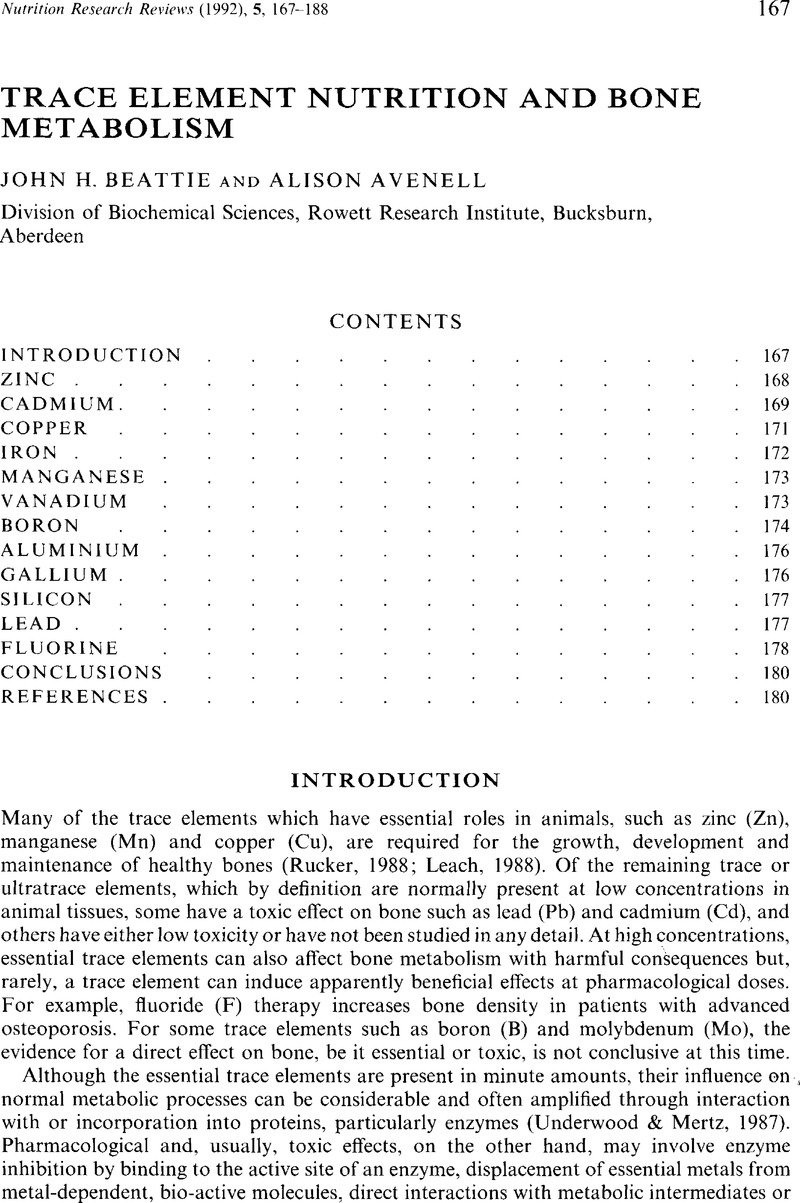Crossref Citations
This article has been cited by the following publications. This list is generated based on data provided by Crossref.
Parry, Nicola M. A.
Phillippo, Michael
Reid, Martin D.
McGaw, Brian A.
Flint, David J.
and
Loveridge, Nigel
1993.
Molybdenum-induced changes in the epiphyseal growth plate.
Calcified Tissue International,
Vol. 53,
Issue. 3,
p.
180.
Eastwood, Martin
1997.
Principles of Human Nutrition.
p.
485.
Abdulla, Mohamed
and
Suck, Catherine
1998.
Blood levels of copper, iron, zinc, and lead in adults in India and Pakistan and the effect of oral zinc supplementation for six weeks.
Biological Trace Element Research,
Vol. 61,
Issue. 3,
p.
323.
Iyengar, G.V.
1998.
Reevaluation of the trace element content in Reference Man.
Radiation Physics and Chemistry,
Vol. 51,
Issue. 4-6,
p.
545.
Strain, J. J.
1998.
Copper and Zinc in Inflammatory and Degenerative Diseases.
p.
173.
Thompson, Katherine H.
McNeill, John H.
and
Orvig, Chris
1999.
Vanadium Compounds as Insulin Mimics.
Chemical Reviews,
Vol. 99,
Issue. 9,
p.
2561.
Yuanxun, Zhang
Deyi, Li
Guisun, Zhuang
Guilin, Zhang
Zhixing, Wang
and
Jun, Xia
1999.
Determination of inorganic elements in iliac crests of rabbits by NAA.
Journal of Radioanalytical and Nuclear Chemistry,
Vol. 240,
Issue. 3,
p.
939.
Swaminathan, R
1999.
NUTRITIONAL FACTORS IN OSTEOPOROSIS.
International Journal of Clinical Practice,
Vol. 53,
Issue. 7,
p.
540.
Sarazin, Marianne
Alexandre, Christian
and
Thomas, Thierry
2000.
Influence des apports en oligoéléments, protéines, lipides, glucides et vitamines sur le métabolisme osseux.
Revue du Rhumatisme,
Vol. 67,
Issue. 7,
p.
486.
Ilich, J. Z.
and
Kerstetter, J. E.
2000.
Management of Fractures in Severely Osteoporotic Bone.
p.
362.
Ilich, Jasminka Z.
and
Kerstetter, Jane E.
2000.
Nutrition in Bone Health Revisited: A Story Beyond Calcium.
Journal of the American College of Nutrition,
Vol. 19,
Issue. 6,
p.
715.
Yuanxun, Zhang
Feng, Cheng
Deyi, Li
Yinsong, Wang
Guilin, Zhang
Hongjie, Xu
Wensheng, Liao
Tingting, Tang
Yuying, Huang
and
Wei, He
2001.
Synchrotron radiation XRF microprobe investigation of elemental distribution in femoral head slice with osteoporosis.
Chinese Science Bulletin,
Vol. 46,
Issue. 13,
p.
1138.
Miekeley, N.
de Carvalho Fortes, L.M.
Porto da Silveira, C.L.
and
Lima, M.B.
2001.
Elemental anomalies in hair as indicators of endocrinologic pathologies and deficiencies in calcium and bone metabolism.
Journal of Trace Elements in Medicine and Biology,
Vol. 15,
Issue. 1,
p.
46.
Almeida, Teresa
Soares, Maria Elisa
Cavalheiro, José
and
de Lourdes Bastos, Maria
2002.
Silicon and iron levels in tissues of animals treated with a “ferrimagnetic ceramic” with oncotherapeutic potential (anti-tumor) value.
Journal of Trace Elements in Medicine and Biology,
Vol. 16,
Issue. 4,
p.
255.
Ilich, J Z
Brownbill, R A
and
Tamborini, L
2003.
Bone and nutrition in elderly women: protein, energy, and calcium as main determinants of bone mineral density.
European Journal of Clinical Nutrition,
Vol. 57,
Issue. 4,
p.
554.
Zhang, Y.X.
Wang, Y.S.
Zhang, Y.P.
Zhang, G.L.
Huang, Y.Y.
and
He, W.
2007.
Investigation of elemental distribution in human femoral head by PIXE and SRXRF microprobe.
Nuclear Instruments and Methods in Physics Research Section B: Beam Interactions with Materials and Atoms,
Vol. 260,
Issue. 1,
p.
178.
Müller, Werner E. G.
Boreiko, Alexandra
Wang, Xiaohong
Krasko, Anatoli
Geurtsen, Werner
Custódio, Márcio Reis
Winkler, Thomas
Lukić-Bilela, Lada
Link, Thorben
and
Schröder, Heinz C.
2007.
Morphogenetic Activity of Silica and Bio-silica on the Expression of Genes Controlling Biomineralization Using SaOS-2 Cells.
Calcified Tissue International,
Vol. 81,
Issue. 5,
p.
382.
Fei, Yurong
Zhang, Min
Li, Ming
Huang, Yuying
He, Wei
Ding, Wenjun
and
Yang, Jianhong
2007.
Element analysis in femur of diabetic osteoporosis model by SRXRF microprobe.
Micron,
Vol. 38,
Issue. 6,
p.
637.
Lall, Santosh P.
and
Lewis-McCrea, Leah M.
2007.
Role of nutrients in skeletal metabolism and pathology in fish — An overview.
Aquaculture,
Vol. 267,
Issue. 1-4,
p.
3.
Zhang, DaWei
Cheng, Yan
Zhang, JinChao
Wang, XinLuan
Wang, NaiLi
Chen, Yao
Yang, MengSu
and
Yao, XinSheng
2008.
Synergistic effect of trace elements and flavonoids from Epimedium koreanum Nakai on primary osteoblasts.
Chinese Science Bulletin,
Vol. 53,
Issue. 3,
p.
347.





